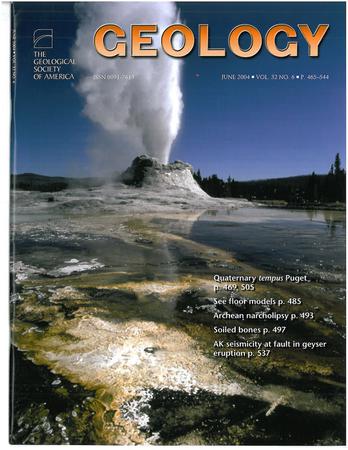Palinspastic restoration of the Olympic orocline and its implications
IF 4.6
1区 地球科学
Q1 GEOLOGY
引用次数: 0
Abstract
The topographic grain and bedrock structure of the Olympic Mountains define a convex-landward horseshoe shape in map view (the Olympic orocline) in the upper plate of the Cascadia subduction zone. This map curvature has been explained as a product of orogen/trench-normal deformation due to accretion and underplating. The basaltic Crescent Formation of the Siletzia terrane outcrops around the periphery of the Olympic Mountains and continues south, underlying much of the “Oregon forearc block.” Regional GPS and paleomagnetic studies demonstrate that the limbs of the Olympic orocline record opposite rotations during overall northward motion relative to cratonic North America. Here, we compile paleomagnetic and structural data to show that the Olympic orocline is a vertical-axis fold. We palinspastically undo the fold, showing that oroclinal folding accommodated 110 km of shortening of the Cascadia forearc. We suggest that subduction underthrusting initially produced a margin-parallel, oceanward-verging fold belt. Oroclinal folding resulted from pinning of the deformed, northward-translating forearc against the Coast Range buttress to the north. Oroclinal bending of the upper plate resulted in the landward retreat of the hinge zone away from the trench, giving rise to passive upward warping of the downgoing Juan de Fuca oceanic lithosphere beneath the growing orocline. Our model provides a deformation sequence that explains the Olympic Mountains as a result of margin-parallel translation and shortening of the Cascadia forearc.奥林匹克斜的恢复及其意义
奥林匹斯山脉的地形颗粒和基岩结构在地图视图上定义了卡斯卡迪亚俯冲带上盘的凸向陆地的马蹄形(奥林匹斯背斜)。这种地图曲率被解释为造山带/海沟正向变形的产物,这是由于增生和底沉积造成的。西莱齐亚地体的新月玄武岩组在奥林匹克山脉外围露头,并继续向南延伸,位于“俄勒冈前弧块体”的下方。区域GPS和古地磁研究表明,在整体北移过程中,奥林匹克造山斜的分支与北美克拉通构造相反。本文通过对古地磁和构造资料的分析,表明奥林匹斯斜是一个垂直轴褶皱。我们对褶皱进行了复原,结果表明,造山斜褶皱使卡斯卡迪亚前弧缩短了110公里。我们认为,俯冲逆冲作用最初形成了一个边缘平行、向海边缘靠近的褶皱带。造山斜褶皱是由变形的、向北平移的前弧与北部的海岸山脉扶壁的固定作用造成的。上板块的造山斜弯曲导致铰链带远离海沟向陆地后退,使下行的胡安·德·富卡洋岩石圈在不断增长的造山斜下被动向上弯曲。我们的模型提供了一个变形序列,解释了奥林匹克山脉是由于边缘平行平移和卡斯卡迪亚前弧的缩短而形成的。
本文章由计算机程序翻译,如有差异,请以英文原文为准。
求助全文
约1分钟内获得全文
求助全文
来源期刊

Geology
地学-地质学
CiteScore
10.00
自引率
3.40%
发文量
228
审稿时长
6.2 months
期刊介绍:
Published since 1973, Geology features rapid publication of about 23 refereed short (four-page) papers each month. Articles cover all earth-science disciplines and include new investigations and provocative topics. Professional geologists and university-level students in the earth sciences use this widely read journal to keep up with scientific research trends. The online forum section facilitates author-reader dialog. Includes color and occasional large-format illustrations on oversized loose inserts.
 求助内容:
求助内容: 应助结果提醒方式:
应助结果提醒方式:


